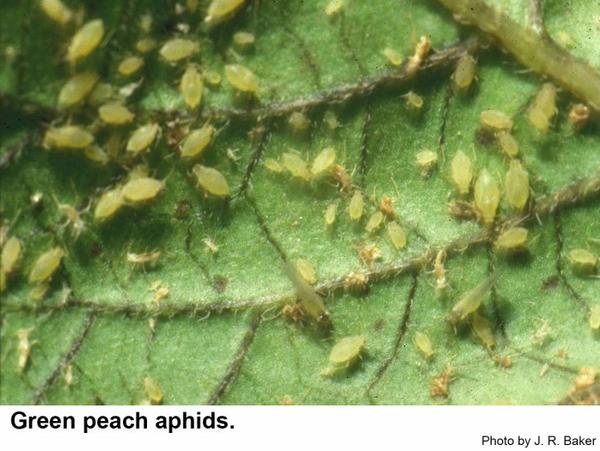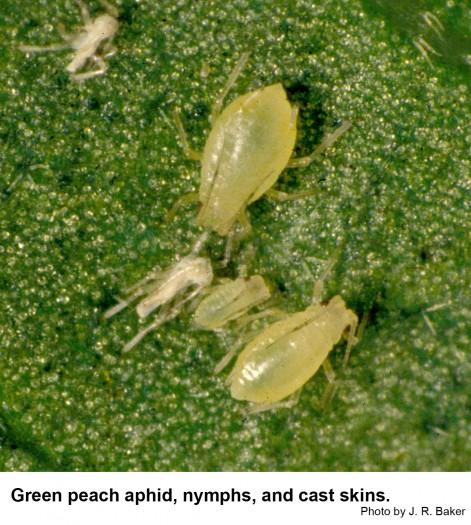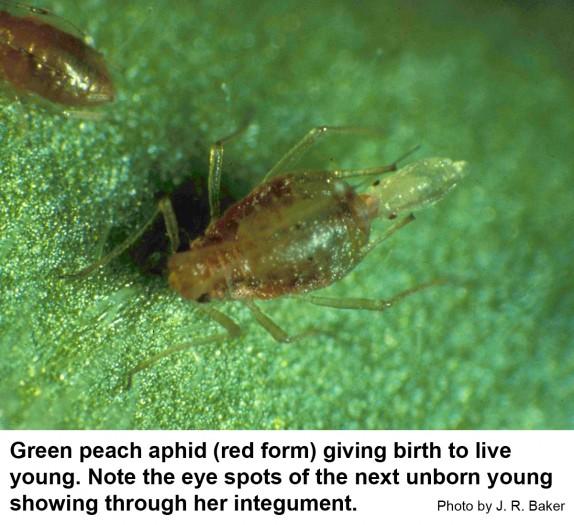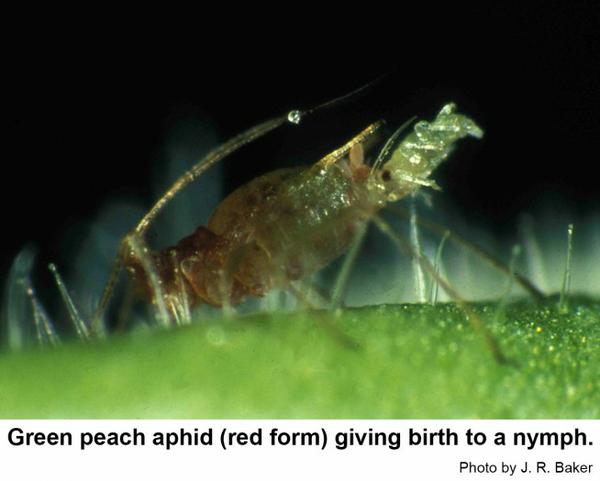Description and Biology
The green peach aphid, Myzus persicae, is light to dark green or pink, with red eyes. Three dark lines run down its back. Adults may or may not be develop wings. Nymphs are wingless and resemble adults. The green peach aphid is a pest all over the world. In the northern United States, green peach aphids overwinter as eggs on Prunus spp, but in the Southeast, no eggs are laid. Instead, female aphids give birth to young females during the growing season. Up to 30 generations occur each year. A complete life cycle may be as short at 12 days.
Host Plants
Its high reproductive rate and resistance to pesticides make the green peach aphid a formidable pest in the greenhouse and to a lesser extent in the landscape, garden, and field crops. Although damage per aphid is often not serious, these aphids reproduce so rapidly that serious harm can be done in a short time. Green peach aphids suck plant sap and contaminate the host with honeydew and cast skins. Sooty molds sometimes grow in the honeydew. Some hospitals refuse to allow cut flowers in patients' rooms because of the mess caused by aphids. Green peach aphids are also the vectors of a number of plant viruses including tobacco, tomato, lettuce, dahlia, canna, and bee mosaics as well as tuber spindle, rugose mosaic, and leaf roll diseases of potato.
Residential Recommendation
Ladybugs, lacewings, syrphid flies, damsel bugs, wasps, and parasitic fungi tend to regulate green peach aphid populations outdoors. Wind, rain, and splashing mud also help check aphid populations outside. The green peach aphid is resistant to many insecticides, including pyrethroids, so use soap or horticultural oil for control. Because some ornamental plants can be somewhat sensitive to pesticides, be sure to water plants thoroughly before spraying them. Treat them in early morning or in late evening so that the pesticide residue is dry before the plants are exposed to direct sunlight.
References
- Aphids on Ornamental Landscape Plants. Steven Frank. 2009. Entomology Insect Notes, NC State Extension Publications.
- Common name: green peach aphid, scientific name: Myzus persicae (Sulzer) (Insecta: Hemiptera: Aphididae). Capinera, J. L. 2017 (revised). Featured Creatures. Entomology & Nematology, FDACS/DPI, EDIS.
- Horticultural Oils for Ornamental Plants. Frank, S. et al. 2018. Entomology Insect Notes, NC State Extension Publications.
- Insect and related Pests of Flowers and Foliage Plants. Baker, J. R., ed. 1994. NC Cooperative Extension Service Pub. AG-136. 106 pp.
- Sooty Molds. Frank, S. et al. 2019 (revised). Entomology Insect Notes, NC State Extension Publications.
- Extension Plant Pathology Publications and Factsheets
- Horticultural Science Publications
- North Carolina Agricultural Chemicals Manual
For assistance with a specific problem, contact your local N.C. Cooperative Extension Center.
This Factsheet has not been peer reviewed.
Publication date: Jan. 5, 2013
Reviewed/Revised: May 6, 2023
Recommendations for the use of agricultural chemicals are included in this publication as a convenience to the reader. The use of brand names and any mention or listing of commercial products or services in this publication does not imply endorsement by NC State University or N.C. A&T State University nor discrimination against similar products or services not mentioned. Individuals who use agricultural chemicals are responsible for ensuring that the intended use complies with current regulations and conforms to the product label. Be sure to obtain current information about usage regulations and examine a current product label before applying any chemical. For assistance, contact your local N.C. Cooperative Extension county center.
N.C. Cooperative Extension prohibits discrimination and harassment regardless of age, color, disability, family and marital status, gender identity, national origin, political beliefs, race, religion, sex (including pregnancy), sexual orientation and veteran status.





